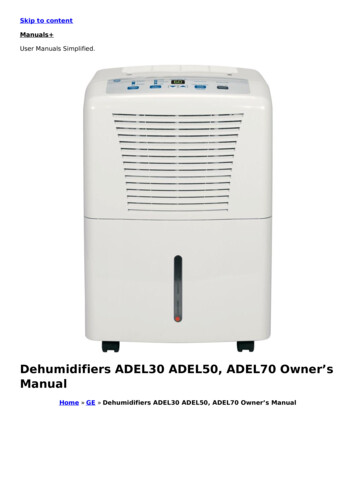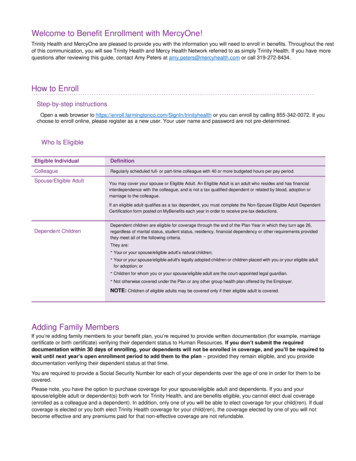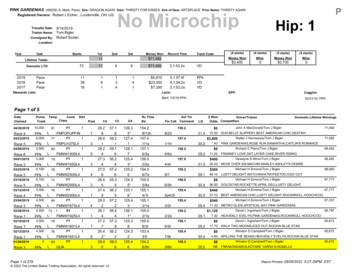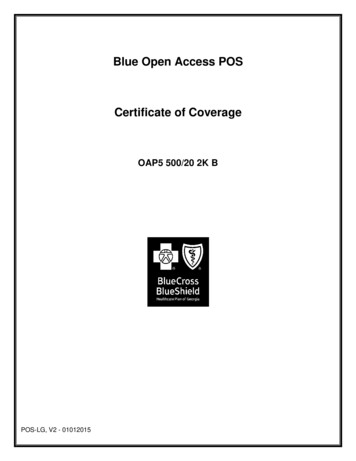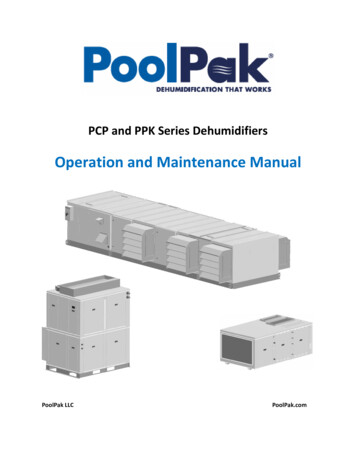
Transcription
PCP and PPK Series DehumidifiersOperation and Maintenance ManualPoolPak LLCPoolPak.com
Table of ContentC ‐ General InformationD ‐ Delivery and Storage Receiving checklist. Shipping Damage handling StorageE ‐ Mechanical Installation Lifting and Rigging General Mechanical Installation Requirementso General Placement of the Equipmento Indoor Dehumidifier Installationo Outdoor Dehumidifier installation Louvers Installation Field‐Installed Outdoor Air Filter Rack Installation Outdoor Air and Exhaust “Door/Louver” Assembly Installation Outdoor Condenser and Fluid Cooler Mechanical Installation Mechanical Installation ‐ Special Caseso “Split‐Deck” Dehumidifier – Mechanical Field Disassembly and Assemblyo “Split‐Cut” Dehumidifier – Mechanical Field AssemblyF ‐ Ductwork Connection Ductwork Layout Considerations Duct Connection – General Considerations Duct Connection – Special CasesG ‐ Piping Connection Piping Connection – General Considerations Condensate Drain Connection and P‐trap Installation Pool Water Heating Connection Outdoor Air Condenser Piping Fluid Cooler Piping Other Piping Systems and Special Caseso Space Heating and Space Cooling Hydronic Systemso Gas‐Fired Space Heaterso “Split‐Cut” Dehumidifier – Piping Assemblyo Remote gas Boiler Package Installation and Piping G‐2G‐3G‐5G‐7G‐7G‐7G‐7G‐8April, 2018
Table of Content (cont‐d)H ‐ Electric Connection: Power, Control and Communication Electrical Connection – General Consideration Equipment Main Power Connection Outdoor Air Condenser and Fluid Cooler Power and Control Connection Field Wiring – External Control and Communicationo Fire/Smoke Detecting System Interlocko Operator Panel Local and Remote Installationo External BMS and Virtual‐Tech Communication Field Wiring – Special Caseso “Split‐Deck” Dehumidifier – Electrical Field Disassembly and Assemblyo “Split‐Cut” Dehumidifier – Electrical Field H‐6H‐6H‐6
C – General InformationGeneral InformationThis manual provides basic information about various installation aspects of the applicable PoolPak LLC (PoolPak)dehumidifier and its additional and auxiliary systems and devices (outdoor condenser, communication interfaces,etc.)Important information regarding operation, maintenance, and start up can be obtained at PoolPak (see Contact Usbelow).Operating Safety (Warnings, Cautions, and Notes)FOR YOUR SAFETY: READ BEFORE PERFORMING ANY INSTALLATION OR OTHER TASKS!Only qualified technicians should install, operate, maintain or service mechanical equipmentincluding PoolPak’s dehumidification system.Make sure to read this manual before performing any installation tasks to familiarize yourselfwith the equipment as well as with any potential hazards. Always exercise caution! Beware of high pressures and chemicals!Dehumidifiers, equipped with compressors, contain refrigerant under high pressure; oil isalso contained in the compressor and refrigeration circuit(s)Some dehumidifiers may also contain other liquids such as glycol mixtures and pool waterThe following warnings, cautions, and notes appear throughout this manual and referenced documentationwhenever special care must be taken to avoid potential hazards that could result in equipment malfunction ordamage, personal injury, or death.WARNINGIndicates a potentially hazardoussituation which could result inserious injury or death if handledimproperly.INM.Z.P.DZ.02CAUTIONIndicates a potentially hazardoussituation which could result inmoderate injury or equipmentdamage if handled improperly.C‐1NoteIndicates a situation that couldresult in equipment damage orimproper/ineffective operation ifhandled improperly.April, 2018
C – General InformationReference and Additional InformationFor safe, efficient and problem‐free operation, it is critical to handle the dehumidifier (as well as related systemsand components) properly at each step ‐ from receiving and storage to installation and start up. Relevantinformation can be found in the respective documents (Operation and Maintenance Manual, Start Up Package,etc.) provided with the dehumidifier.This manual and other related documents can also be obtained at PoolPak ‐ see Contact Us below.WarrantyThe PoolPak standard warranty statement can be found in the Operation and Maintenance Manual, provided withthe equipment (also can be obtained at PoolPak ‐ see Contact Us below).Attention: Warranty Conditions and Coverage.NOTE. PoolPak equipment is provided with comprehensive conditional warranty coverage. Any warranty workto be reimbursed must be approved by PoolPak Customer Support Team prior to work commencing. Installation,start up, maintenance etc. are not within warranty scope.Refer to the PoolPak standard warranty statement for more details on warranty conditions, scope and coverage.Attention: Equipment Proper Usage.CAUTION! Dehumidifier is NOT intended, and, therefore, NOT to be used, to condition (heat, cool,ventilate etc.) premise that is still under construction. Such usage may cause equipment premature wear, poorperformance and potential failure afterwards and will void the warranty!WARNING! Any work (installation, start up, service, maintenance, repair, etc.) on any mechanicalequipment (dehumidifier, outdoor condenser, fluid cooler, etc.) must be performed in accordance withrespective PoolPak recommendations as well as submittal documentation, local Codes and Regulations, andappropriate field practices. Failure to do so could result in personal injury, equipment damage or malfunction,and will void equipment warranty. Only qualified and properly trained individuals should perform tasks on thisequipment.Contact UsHeadquarterPoolPak LLC3491 Industrial DriveYork, PA 17403 USAPhone:Main mservice@poolpak.comparts@poolpak.com
D – Shipping and StorageDelivery and Storage.Receiving ChecklistPoolPak inspects and fully tests each piece of equipment before it ships from the factory; however, the equipmentmay suffer damage in transit.It is highly recommended to thoroughly check for both visible and concealed damage upon the equipment arrivaland before signing the receiving papers: Visually inspect exterior of the equipment for damages (scratches, dents, missing elements, etc.)Verify the proper operation of latches and hinges on all access doorsInspect all coils for damage to the fin surface coating, headers or coil connectionsManually rotate the fan wheel to ensure free movement of the shaft, bearings, and driveInspect the fan housings for any foreign objectsInspect and test all piping for possible shipping damageCheck the tightness of bolts on the fan structure and coilsInspect fan isolator shipping bracketsShipping Damage HandlingPoolPak ships freight on board (FOB), meaning that the equipment belongs to the customer as soon as the deliverytruck leaves the factory.Note: PoolPak is not responsible for any shipping damage. Should the equipment arrive damaged, follow theinstructions below to resolve the situation. Delivery cannot be refused on the basis of shipping damage. Shipping Damage Handling Instructions:Note the damage in detail on the freight bill and bill of lading.Take clear photographs of the damaged components, areas, and portions of the equipment.Obtain a claim form from the carrier, fill it out, and return it promptly. Report all claims of shipping damage tothe carrier immediately and coordinate a carrier inspection if necessary.Contact PoolPak Customer Support (see Contact Us above) to notify of the noted damage.o Have the equipment serial number (8‐digit) on hand to provide to Customer Support. The serialnumber can be found on the equipment’s main label or bill of lading.o Note: it is the receiver's responsibility to provide reasonable evidence that damage was not incurredafter delivery.o Do not attempt to repair the equipment without consulting with PoolPak Customer Support.INM.Z.P.DZ.02D‐1April, 2018
D – Shipping and StorageStorage Protection from the elements is required for any equipment that will be stored on a job site or holding areabefore installation.For long‐term storage, a controlled indoor environment is highly recommended.All factory‐applied shipping protection should be removed before the equipment is put into storage. Shippingprotection material is provided by the factory for shipping only – it is not a suitable protection for short orlong‐term storage.If long‐term storage is required, warranty aspect should be considered. Refer to the Warranty section ofOperation and Maintenance Manual for more details. Please contact PoolPak if you have any questions.D‐2
E – Mechanical InstallationMechanical InstallationWARNING! All work must be done by qualified personnel in accordance with local and national Codes,Standards and Regulations as well as respective design/submittal documentation and PoolPak recommendations.CAUTION! Obtain all necessary documentation (PoolPak documentation, submittal documentation,drawings, etc.) and familiarise yourself with it before performing installation or any other related tasks.Lifting and RiggingWARNING! Lifting and rigging must be done by trained professionals in accordance with proper liftingtechniques and safety procedures. Proper lifting machinery and tools and safety equipment (PPE) must be used.Improper lifting may cause equipment damage, serious injury, or death. PoolPak is not responsible for theimproper use of lifting equipment. Use spreader bars for lifting to prevent equipment damage. Use cables (chains or slings) as shown on Pic. E.1.o Use dehumidifier lifting brackets atthe base frame.Each of the lifting cables (chains or slings)must be capable to support the entireweight of the equipment.Determine the approximate centre ofgravity before lifting. See equipment designdrawings in the submittal documents for thetotal weight and weight distribution.Lifting cables (chains or slings) may not be ofthe same length. Adjust as necessary for aneven lift.Do not lift equipment in windy conditions.Do not raise equipment overhead withpersonnel below.Test lift the equipment 24 inches to verifyPic. E.1proper operation of lifting machinery andpositioning of lift points such that the lifted equipment is level.To avoid damage, do not attach intake or exhaust hoods prior to lifting“Split‐Cut” Dehumidifier LiftingSome dehumidifiers may, if requested, be shipped in sections to be assembled on site. Never assemble split sections before lifting them to the installation location.o Always lift sections separately, as received from the factory.Lift each section using its lifting lugs/brackets.INM.Z.P.DZ.02E‐1May, 2019
E – Mechanical InstallationGeneral Mechanical Installation RequirementsEquipment (dehumidifier, outdoor condenser, fluid cooler, etc.) should be installed in accordance with respective local Codes andRegulations as well as applicable submittal documentation. There are several general key installation points:General Placement of the Equipment Equipment must be installed on a firm, levelled surface, with provision for vibration absorption.Service and operational clearances to the equipment must be always maintained.o Access to ALL doors, louvers, filter racks, access ports and covers must not be restricted. Someinstallations may require cat‐walks (over ducts, pipes, etc.) or other means of access to otherwiserestricted side of the equipment.o Dehumidifier: may require up to 30” clearance for proper operation, service and maintenance;o Outdoor Condenser (OACC)/Fluid Cooler (OAFC): may require up to 36” clearance all around and upto 96” clearance above fan for proper operation, service, and maintenance. Avoid installing OACC/OAFC in a pit, where it’s surrounded on all four sides by walls,structures, etc. If such an installation cannot be avoided, the following must be maintained: the min. clearances must be increased to double width of the OACC/OAFC all around; surrounding structures’ height must not exceed the height of the OACC/OAFC.NOTE. For equipment‐specific data (dimensions, clearances, accessibility, etc.) refer to equipment submittaldocumentation, Operation and Maintenance Manual, and equipment labels and stickers.Indoor Dehumidifier Installation (dehumidifier, installed in mechanical room) No chemicals allowed to be stored in the same mechanical room;o other stored materials must not block access to the equipment for service and maintenance.Mechanical room must have operational floor drain.Ceiling‐suspended installation: support dehumidifier from (underneath) the base; for proper selection andpositioning of support ‐ refer to submittal documentation for dehumidifier weight distribution.Outdoor Air (OA) intake box. Some dehumidifiers with outdoor intake option, may have an OA intake box,mounted onto the OA intake opening or provided separately to be field‐installed. If latter is the case:o install box over the OA opening, attach it to the dehumidifier with provided self‐tapping screws.o Attach OA duct to the box (see DuctworkJunction boxConnection chapter).o Control/electrical contractor: connectcontrol wire harness to the OA box devices(actuators, sensor etc.) inside the junctionbox (see Pic. E.2) – follow the junction boxPic. E.2legend and dehumidifier wiring diagram.Outdoor Dehumidifier Installation Roof Curb. If the dehumidifier is installed on a roof curb, it must utilize curb gasket material (to create amoisture and weather seal between the dehumidifier and a roof curb).o ATTENTION! Before placing onto a roof curb, consider accessibility underneath the dehumidifier forvarious mechanical and electrical systems connections (power, drain, other piping, etc.)o ATTENTION! It is not recommended to use space within a roof curb as a supply or return duct.Consider the direction of strong prevailing winds – it may negatively affect equipment operation (cross‐flow ofexhausted and fresh air and/or flue gases, elements (rain, snow) aspiration into the OA opening, etc.)E‐2
E – Mechanical InstallationOutdoor Dehumidifier – Louvers InstallationTo protect outdoor‐installed dehumidifier openings (outdoor air intake, exhaust air discharge, etc.) againstelements, louvers are installed or provided separately for field installation. If latter is the case: Uncrate/unwrap provided louver and place it over respective opening/damper (Pic. E.3):o Larger louvers require two persons to lift and place the louvero Dehumidifier with larger louvers also have louver support lip over the damper. Adjust louver position – shift it slightly left or right as needed to ensure louver side walls and access panels donot interfere with damper linkage, actuators, filter racks, sensors, etc. Once the louver is positioned properly, attach it to the dehumidifier with the provided self‐tapping screws onall four sides. If access panels were removed for louver installation, reattach the panels and close the latch.Support lipCover panelPic. E.3Outdoor AND Indoor Dehumidifier ‐ Field‐installed OA (outdoor air intake) Filter Rack InstallationIf the Outdoor Air intake (OA) filter rack is shipped separately, it should be attached to respective opening/damperonce dehumidifier is installed. This may apply to both, indoor and outdoor installed dehumidifiers. Attach filter rack to the damper with provided self‐tapping screws; position rack as shown on Pic. E.4.Once the rack is installed, insert/install OA sensor (thermistor or combo sensor, as shown in the picture)between the damper and the filters; ensure that the sensor will not interfere with the damper blades motion.OA sensorPic. E.4INM.Z.P.DZ.02E‐3May, 2019
E – Mechanical InstallationOutdoor Dehumidifier – Outdoor Air and Exhaust “Door/Louver” Assembly InstallationFor shipping purposes, the OA and Exhaust Louver(s) may be shipped on the top of the dehumidifier and willrequire field installation (Pic. E.5). This normally applies to outdoor PCP1400‐PCP3000 series dehumidifiers only. Remove the door/louver assembly (a) from the roof and place it in front of the respective opening; normally,the air damper with pre‐wired actuator is mounted within the louver – use caution not to damage wiring.o The OA door/louver assembly is normally placed on the roof near/above OA opening. The Exhaustdoor/louver assembly, respectively – near/above Exhaust opening.Release louver latches (b) on both sides to open the louver and access bolts (c) later;Place door support brackets (d) on the dehumidifier floor into the opening,Lift the door and place it, then tighten bolts (c) to secure the door.o OA damper would also have a filter rack, attached to it.Lift the hood in place and lock the latches (b).(a)(d)(b)(c)Pic. E.5E‐4
E – Mechanical InstallationOutdoor Condenser (OACC) and Fluid Cooler (OAFC) Mechanical InstallationThe requirements outlined in General Placement of the Equipment (see above) apply to all models of OACC/OAFC. It is recommended to anchor light‐weighted OACC/OAFC to the horizontal mounted surface (concrete pad etc.).This applies to all OACC models and some OAFC models (NG‐Z and NG‐V‐01, ‐02, ‐11 and ‐12).NOTE. Do NOT exceed distance limitation between the dehumidifier and OACC or OAFC – it may result inequipment incorrect operation and/or failure. Before finalizing OACC or OAFC placement/location, refer torespective dehumidifier main label, as well as submittal documentation and Fluid Cooler Piping and OutdoorCondenser Piping chapters of current manual (see further). Contact the factory if needed.Outdoor Condensers and Fluid Coolers Field Assembly – models NC‐Z, NC‐B and NG‐Z.The NC‐Z and NC‐B Series outdoor condensers as well as NG‐Z Series fluid coolers can be provided in vertical orhorizontal airflow configuration and may require field assembly of respective mounting support:Vertical airflow configuration (equipment is mounted on a horizontal surface such as ground, roof, etc.): OACC model NC‐Z and OAFC model NG‐Z assembly is shown on Pic. E.7A below:o Uncrate/unwrap the equipment and legs.o Install the four provided legs (a) onto the equipment (leg is to be placed inside in the corner) Double condenser/cooler (b) would have six legs provided – place two additional legs in themiddle – refer to picture.o Align all four holes in each leg and equipment corner and attach legs with provided bolts, washers (legshave factory‐installed nut‐certs); tighten all bolts.o Ensure that the equipment is levelled and firm; affix the legs to the surface (concrete slab, etc.);anchors/fasteners for surface mounting are NOT included.Pic. E.7AINM.Z.P.DZ.02E‐5May, 2019
E – Mechanical Installation OACC model NC‐B assembly is shown on Pic. E.7B below:o Uncrate/unwrap the condenser and mounting kit.o Assemble left and right mount legs as shown with provided bolts, nuts, and washers (except for jointpoint (a) – it must be bolted to the condenser)o Align holes (a) and (b) in the mount legs with the holes in the condenser and attach them with providedbolts, nuts and washers.o Attach rear support braces to the condenser with provided self‐tapping screws (c)o Install the optional front cross piece (d) between left and right leg with provided bolts, nuts andwashers;o Ensure that the assembly is straight, square and sturdy; tighten all bolts.o Ensure that the condenser is levelled and firm; affix mount legs footings to the surface (concrete slab,etc.); anchors/fasteners for surface mounting are NOT included.Pic. E.7BHorizontal airflow configuration (equipment is mounted on a vertical surface such as a wall.). In this case, use thesame mount kit as above. Note that the mount legs are assembled slightly differently. OACC model NC‐Z and NC‐B and OAFC model NG‐Z assembly is shown on Pic. E.7C below:o Uncrate/unwrap the equipment and mounting kit.o Assemble left and right mount legs as shown with provided bolts, nuts, and washers (except for jointpoint (a) – it must be bolted to the condenser/cooler) Note that the cross‐piece (b), that is to be attached to the equipment, is mounted differentlyfor NC‐Z/NG‐Z and NC‐B.o Before final assembly of equipment and mount legs, ensure following: For Outdoor Condenser NC‐B: electric box is positioned as shown – horizontal, with dripprotection bend (c) at the top; For all Outdoor Condensers (NC‐Z and NC‐B): refrigerant connections are on the side ANDliquid line connection (refer to condenser labels) is the bottom one, (e).o Align respective holes in cross‐piece (b) and the holes in the equipment and attach them with providedbolts, nuts, and washers.o Attach rear support braces to the condenser with provided self‐tapping screws (d)o Ensure that the assembly is straight, square, and sturdy; tighten all bolts.o Ensure that the condenser is levelled and firm; affix mount legs footings to the surface (wall, etc.);anchors/fasteners for surface mounting are NOT included.E‐6
E – Mechanical InstallationPic. E.7CATTENTION! Cooling Fluid Lines Sweating!Under certain conditions (namely – when the cooling fluid lines’ outer surface drops below dew point of thesurrounding air, particularly inside the facility), said lines may “sweat” as condensation forms on their surface.Should this occur, it is recommended to insulate the piping to prevent condensation.INM.Z.P.DZ.02E‐7May, 2019
E – Mechanical InstallationMechanical Installation – Special CasesSome equipment may have additional/optional arrangements – refer to submittal documentation and equipmentaccompanying factory instructions.Frame‐mounted main blower shipping brackets.For shipping purposes, larger (7 HP and up) direct‐driven main blower frame springs are affixed with shippingbrackets (see Pic. E.8). This normally applies to LD series dehumidifiers only. Upon installation remove ONLY lower bolt from all four corners (detail A) at the frame base ‐ removing thesebolts ensures that the blower vibration is dampened correctly. If the blower frame includes two blowers (stack), in addition tobase bolts removal (described above) remove ONE bolt fromeach bracket at the wall springs (B).(B)Pic. E.8E‐8
E – Mechanical Installation“Split‐Deck” dehumidifier (“Double‐Decker”) – mechanical field disassembly and assemblyIf requested, “Double‐decker” (stacked)dehumidifiers are provided with means for sitedisassembly (splitting top deck from the bottomfor shipping/delivery purposes) and assemblyafterwards. Refer to Disassembly and assemblyInstructions, provided with the dehumidifier!CAUTION!(b)Before removing top deck from the bottom,ensure that ALL other system connections(piping, wiring, etc.) are disassembled.Normally, there are two ways the top deck isattached to the bottom (refer to the onepertaining to your dehumidifier): PCP808 – PCP5050 indoor models: decksattached with six to eight screws throughthe top deck floor & bottom deck roof (seePic. E.9a):o locate the plastic covers/plugs at the front (a) and back (b) of the dehumidifier and popthem open to access screws;o remove all the screws and lift the top deck.o Once decks reassembled, reinstall removed screws and reinstall plastic covers.PCP3030 – PCP5050indoor/outdoor models: decksattached with side joining andlifting strips (see Pic. E.9b):o Locate and remove allscrews on joining stripsbetween the top and(a)bottom decks ‐ on thefront (a) and back (b)joining strips and on thelifting bracket strips (c) onthe sides of thedehumidifier.o Once the dehumidifier isinstalled and decks arereassembled, make sureto reinstall the removed(c)screws again.o Remove as needed the lifting eye‐hooks to allow for doors removal.(a)Pic. E.9a(b)Pic. E.9bMake sure to also reassemble the other system connections (piping, wiring, etc.). Refer to respective chapters.INM.Z.P.DZ.02E‐9May, 2019
E – Mechanical Installation“Split‐Cut” dehumidifier – mechanical field assemblyUnder special conditions, the dehumidifier may be split into two or more sections to ease the installation anddelivery process. Refer to the dehumidifier submittal drawings and Disassembly and Assembly Instructions,provided with the dehumidifier (instructions include mechanical, piping, and electrical guidance for reassembly).This normally applies to outdoor PCP3000‐PCP5000 series dehumidifiers only.WARNING! DO NOT lift assembled dehumidifier. Lift each section separately and assemble once allsections are placed where intended. Place and align dehumidifier sections properly:o To aid with proper placement, sections normally are labeled with sequential numbers (“1”, “2” etc.) –ensure that each pair of adjacent sections at the split have same number (see Pic. E.10a).o Before final assembly of sections – ensure piping proper alignment; plan for pipe joining.Join sections with provided fasteners.o Base angles (outside – seePic. E.10. b) are normallybolted together with 3/8”bolts and internal (walls,floor, ceiling) angle (inside– see Pic. E.10 c) arenormally attached with5/16” bolts. Note thatPic.E.10ainternal angles shape mayvary depending ondehumidifier cabinet type.o Ensure that all provided holes are used.Install provided roof rib cap (see Pic. E.10 d) over each jointed roof rib and attach it with screws; caulk theinner corner of roof rib cap prior.Caulk all the joints (roof, floor, walls) after reassembly.Pic.E.10bPic.E.10cPic.E.10dE‐10
F – Ductwork ConnectionDuctwork ConnectionWARNING! All work must be done by qualified personnel in accordance with local and national Codes,Standards and Regulations as well as respective design/submittal documentation and PoolPak recommendations.CAUTION! Obtain all necessary documentation (PoolPak documentation, submittal documentation,drawings etc.) and familiarise yourself with it before performing installation or any other related tasks.Refer to dehumidifier submittal drawings for location and size of dehumidifier duct connections.Ductwork Layout ConsiderationsThough ductwork layout is outside of scope of dehumidifier installation and duct connection to it, it is crucial tohave proper ductwork layout for proper air distribution throughout the premise and proper dehumidifieroperation. Proper ductwork layout encompasses, among others, following: Supply air must be directed/properly distributed to:o exterior windows and doors, skylights, etc.o breathing zone at the deck level and water surface.o remainder of the room to ensure there are no stagnant areas.Return duct grille must be located where it will optimize the entire airflow pattern (central/equidistantlocation of return grille, multiple return grilles if needed, etc.).Air short‐circuiting must be prevented – no supply air diffusers near the return.Ensure grilles, diffusers and registers are delivering proper throw distance and CFM.Maintain the required minimum OA intake along with negative pressure in the space (respective Exhaust Fanand OA intake arrangement)Where/if applicable, establish direct exhaust of humid/chemical laden air from the source (locate exhaustgrille above/close to spa, whirlpool, etc.).Duct sock installation: sock must be levelled (hangers are at the same heights), stretched and not sagging.Duct Connection – General Considerations All duct connections should be done in accordance with local and national standards.o Proper duct turns and transitions (sizing, distance, angles, turn vanes, etc.) should be used to minimize airfriction losses and turbulence and to ensure the highest fan efficiency.o If space heater (electric heater, hot water coil or gas duct heater) is installed at the dehumidifiersupply air termination, heater becomes a point for the supply duct connection – ensure properduct transition, support, etc. is in place – refer to heater manufacturer guidance as needed.o Flexible connectors (canvas collars, etc.) should be used to prevent (reduce) vibration and soundpropagation.Ductwork should not interfere with other devices/systems operation and accessibility:o fasteners (screws, etc.) attaching ducts to the damper, are not interfering with damper linkage,actuator(s) wiring and mounting brackets etc.o fasteners (screws etc.) are not interfering/penetrating any internal wiring, piping etc. possibly locatedbehind the surface(s) ductwork is attached to – verify visually before installation and after.o damper actuator(s), filter racks, etc. are accessible/not blocked by the installed ductwork.INM.Z.P.DZ.02F‐1April, 2018
F – Ductwork ConnectionDuct Connection – Special CasesSupply Air ductwork connection – SA Temperature Sensor installation.Some dehumidifiers may require SA (supply air) temperature sensor to be installed in the duct after duct isconnected.In this case dehumidifier SA temperature sensor,tagged “SUPPLY AIR TEMP SENSOR TO BEINSTALLED IN DUCT” (see Pic. F.1), would beattached to the side or roof of the dehumidifier ‐such sensor is pre‐wired to the dehumidifiercontrol board at the factory and needs to beinstalled in supply ductwork. Install sensor at least 2’‐ 4’ downstreamof the dehumidifier or externallymounted space heater (if one iscontrolled by the dehumidifier) in themiddle of the width of the duct.Pic.F.1Field‐installed duct‐mounted space heater.If space heater (gas duct heater, hot water or steam coil, electric heater, etc.) is not packaged with thedehumidifier and to be installed in the duct on site: follow said space heater manufacturer installation instructions (duct transitions, distances, clearances,support, direction, etc.), respective local codes and regulations and standard field practices. Install space heater in the supply duct, downstream of the dehumidifier. It is recommended for the space heater to be controlled by the dehumidifier control system (for efficientoperation and air temperature maintenance). Gas‐fired duct heater. Indoor‐installed gas heater requires respective venting to be installed. Follow theheater manufacturer recom
Pool Water Heating Connection G‐2 . o Space Heating and Space Cooling Hydronic Systems G‐7 o Gas‐Fired Space Heaters G‐7 o "Split‐Cut" Dehumidifier - Piping Assembly G‐7 . Dehumidifiers, equipped with compressors, contain refrigerant under high pressure; oil is also contained in the compressor and refrigeration circuit .
